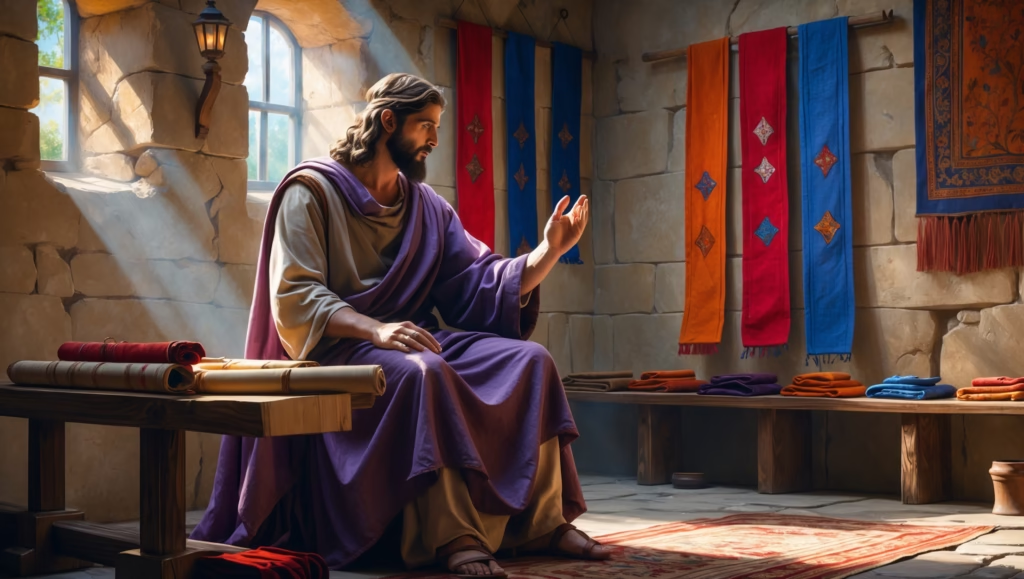How Jesus Saw and Used Color Symbolism
Color in the ancient world was more than aesthetic; it conveyed social status, spiritual meaning, and cultural identity. Studying how Jesus perceived and utilized color in His ministry sheds light on His teachings, the material culture of 1st-century Judea, and the symbolic literacy of His audience. By combining archaeological evidence, historical sources, and theological reflection, we can reconstruct the chromatic environment of the Messiah.

Ancient Color Technology
Available Dyes and Pigments
1st-century Judea had access to a surprisingly diverse palette of natural colors, though they were limited by production methods, trade networks, and cost:
- Tyrian Purple: Extracted from Murex shells along the Phoenician coast, this dye symbolized royalty. Biblical references (Mark 15:17) suggest Roman soldiers used purple robes to mock Jesus’ kingship. Modern estimates place its value at $30,000 per pound, making it inaccessible to most people.
- Indigo: Imported from India, indigo dye was occasionally found in Masada excavations. It produced deep blue fabrics that were prized for ceremonial use.
- Madder Root: Locally grown in Judea, madder produced reds and faded purples, often used for lower-cost clothing or mockery robes. This is likely the source of the “faded purple” used in Jesus’ trial, conveying mock-royalty symbolism.
- Earth Pigments: Ochres, cinnabar, and charcoal were used for more common colors in clothing, murals, and temple decorations.
Color Perception Considerations
- Studies suggest 8% of ancient males were red-green colorblind, which may have influenced descriptions in texts like Isaiah 1:18 (“white as snow”) or Matthew 27:28 (scarlet thread). Colors that appear vivid to modern readers may have looked differently to contemporary audiences.
- Cultural interpretation also played a role—symbolic meaning often trumped visual accuracy, with red, purple, and white carrying moral, spiritual, or societal messages.
Theological Color Coding in the Gospels
Color was not incidental in Jesus’ life and teachings; it conveyed meaning:
- Purple Robe (Mockery and Kingship):
The soldiers’ placement of a purple robe on Jesus (Matthew 27:28; Mark 15:17) was a deliberate theatrical act. The color, though faded due to cheaper dyes, symbolized mock-royalty, turning a powerful visual cue into a lesson on humility and divine kingship. - Sight Miracles and Mud Symbolism:
In healing the blind man (John 9), Jesus used mud mixed with saliva. The brownish hue of the mud may have held symbolic weight: earthiness, humility, and human dependence on divine intervention. The act visually reinforced the miracle while connecting to familiar color cues in the community. - Scarlet Thread in Temple or Sacramental Contexts:
Matthew 27:28 references a scarlet thread, likely crimson rather than pure scarlet, due to regional dye limitations. This subtle chromatic choice would have been perceptible to first-century observers familiar with available textiles, serving as a coded theological message of sacrifice and redemption. - Liturgical Colors in Synagogue and Temple Practices:
Priestly garments, altar coverings, and festival decorations used color intentionally. Blue (tekhelet), purple (argaman), and scarlet (tola’at shani) were associated with divine presence, kingship, and covenant fidelity. Jesus’ teaching often referenced these symbolic colors implicitly through metaphors, parables, and observable rituals.
Modern Worship Arts and Applications
- Digital Restoration of Biblical Sites:
Archaeologists and digital artists reconstruct the original colors of biblical-era sites. Using spectral imaging and dye residue analysis, researchers can restore frescoes, pottery, and synagogue murals to their historically accurate chromatic states, offering modern worshippers a sensory bridge to the ancient world. - Liturgical Art Installations:
Contemporary churches have created installations like “Colors of Christ,” using projected light and pigment-rich media to illustrate the symbolic and theological meaning of color in Jesus’ ministry. These installations educate congregations about how color reinforced messages in parables, miracles, and ritual contexts. - Educational and Devotional Implications:
- Understanding the limits of dye technology enhances our interpretation of Gospel narratives.
- Recognizing how colorblindness and cultural perception shaped first-century experiences deepens engagement with the text.
- Art and worship practices can intentionally employ historical color symbolism to enrich contemporary faith experiences.
- Understanding the limits of dye technology enhances our interpretation of Gospel narratives.
Key Discoveries and Insights
- The purple robe was likely faded madder root dye, not true Tyrian purple, reinforcing the mockery narrative.
- Mud for sight miracles may have been chosen for its earthy tone, emphasizing humility and divine-human interaction.
- Scarlet threads referenced in Scripture were crimson-hued, reflecting practical dye limitations and symbolic depth.
- Digital reconstructions allow modern audiences to visualize color as first-century worshippers experienced it.
- Archaeological evidence from Masada, Sepphoris, and Judean textile fragments confirms the availability of blue, purple, red, and earth-tone pigments.










